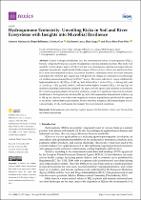Please use this identifier to cite or link to this item:
https://repositorio.usj.es/handle/123456789/1148
| Title: | Hydroquinone Ecotoxicity: Unveiling Risks in Soil and River Ecosystems with Insights into Microbial Resilience |
| Authors: | Valenzuela, Antonio Ballestero Fernández, Diego Gan, Cristina 


Lorca, Guillermo Langa Morales, Elisa 
Pino Otín, Rosa 

|
| Keywords: | Hydroquinone; Acute toxicity; Daphnia magna; Aliivibrio fischeri; Allium cepa; Eisenia fetida; Microbial communities |
| Issue Date: | 29-Jan-2024 |
| Publisher: | MDPI |
| Citation: | Valenzuela, A.; Ballestero, D.; Gan, C.; Lorca, G.; Langa, E.; Pino-Otín, M.R. Hydroquinone Ecotoxicity: Unveiling Risks in Soil and River Ecosystems with Insights into Microbial Resilience. Toxics 2024, 12, 115. https://doi.org/ 10.3390/toxics12020115 |
| Abstract: | Despite widespread industrial use, the environmental safety of hydroquinone (HQ), a benzene compound from plants used in processes like cosmetics, remains uncertain. This study evaluated the ecotoxicological impact of HQ on soil and river environments, utilizing non-target indicator organisms from diverse trophic levels: Daphnia magna, Aliivibrio fischeri, Allium cepa, and Eisenia fetida. For a more environmentally realistic assessment, microbial communities from a river and untreated soil underwent 16S rRNA gene sequencing, with growth and changes in community-level physiological profiling assessed using Biolog EcoPlate™ assays. The water indicator D. magna exhibited the highest sensitivity to HQ (EC50 = 0.142 μg/mL), followed by A. fischeri (EC50 = 1.446 μg/mL), and A. cepa (LC50 = 7.631 μg/mL), while E. fetida showed the highest resistance (EC50 = 234 mg/Kg). Remarkably, microbial communities mitigated HQ impact in both aquatic and terrestrial environments. River microorganisms displayed minimal inhibition, except for a significant reduction in polymer metabolism at the highest concentration (100 μg/mL). Soil communities demonstrated resilience up to 100 μg/mL, beyond which there was a significant decrease in population growth and the capacity to metabolize carbohydrates and polymers. Despite microbial mitigation, HQ remains highly toxic to various trophic levels, emphasizing the necessity for environmental regulations. |
| URI: | https://repositorio.usj.es/handle/123456789/1148 |
| ISSN: | 2305-6304 |
| Appears in Collections: | Artículos de revistas |
Files in This Item:
| File | Description | Size | Format | |
|---|---|---|---|---|
| Hydroquinone Ecotoxicity.pdf | 4,5 MB | Adobe PDF |  View/Open |
This item is licensed under a Creative Commons License

